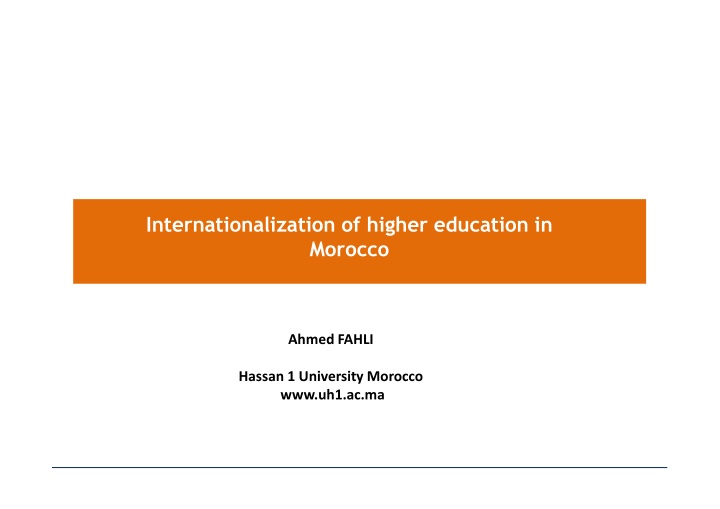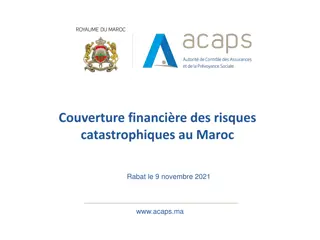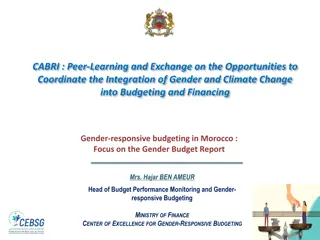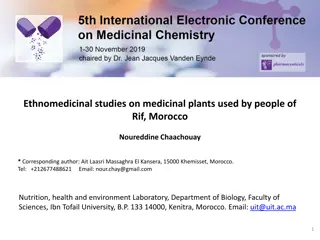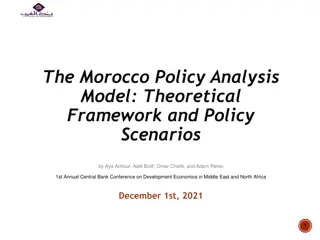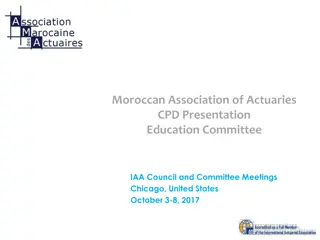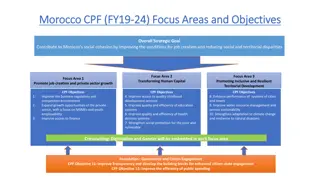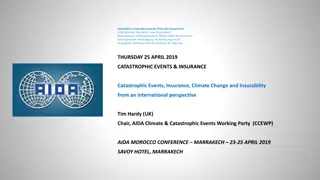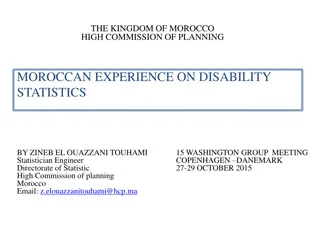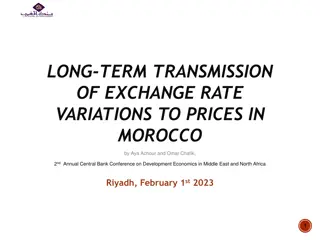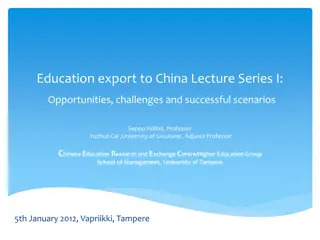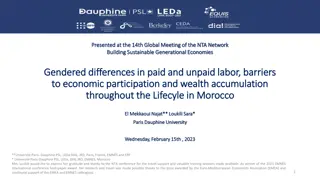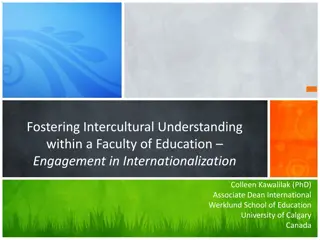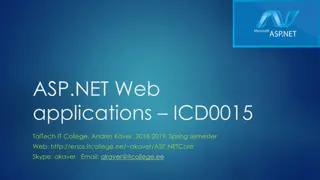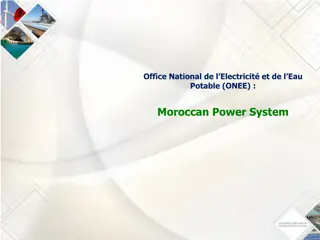Internationalization of higher education in Morocco
Overview of the Moroccan higher education system and the internationalization efforts at Hassan 1 University, including purposes, strategies, and mechanisms. The system includes public universities, institutions under technical ministries, and private higher education initiatives. Explore components, potential training, key figures, and the training offer in Morocco for both local and foreign students.
Download Presentation

Please find below an Image/Link to download the presentation.
The content on the website is provided AS IS for your information and personal use only. It may not be sold, licensed, or shared on other websites without obtaining consent from the author.If you encounter any issues during the download, it is possible that the publisher has removed the file from their server.
You are allowed to download the files provided on this website for personal or commercial use, subject to the condition that they are used lawfully. All files are the property of their respective owners.
The content on the website is provided AS IS for your information and personal use only. It may not be sold, licensed, or shared on other websites without obtaining consent from the author.
E N D
Presentation Transcript
Internationalization of higher education in Morocco Ahmed FAHLI Hassan 1 University Morocco www.uh1.ac.ma
SUMMARY 1 Overview of the Moroccan higher education 2 Internationalization of H.E : Purposes, Strategies ,and Mechanisms 3 Towards a modernization to manage the internationalization of H.E in Morocco
SOMMAIRE 1 Overview of the Moroccan higher education 1.1 1.1 Components of the system 1.2 1.2 Potential training 1.3 1.3 Key figures 1.4 1.4 Training offer 1.5 1.5 Foreign students in Morocco
Morocco Morocco is is 7 7 hours My My university hours direct flight direct flight from university is is 30 minutes 30 minutes from from new from the new work work Casablanca. Casablanca. the aereport aereport
1. Overview of the higher education system 1.1 Components of the system Creations under a partnership Private Higher Education Public higher education Institues not under universities Universities and Institutes Universities and Institutes Universities Under the administrative and financial tutelage of technical ministries Non-profit foundations, created as part of the dynamics of internationalization of higher education Under the pedagogical authority of the ministry of Higher Education, scientific research and training Created in a private initiative Under tutelage ministry of Higher Education, scientific research and training the the of Under the pedagogical authority of the ministry of Higher Education, scientific research and training Under the pedagogical authority of the ministry of Higher Education, scientific research and training .
1. Overview of the higher education system 13 Public University with private management 1 Public Universities Univ. Al Quaraouiyine Univ. Al Akhawayn Univ. Mohammed V-Rabat Universities as part of the Partnership (16 institutions) 5 Univ. Hassan II-Casablanca Univ. Sidi MohammedBen Abdellah-F s Engineering Schools created under the Partnership: Ecole Centrale de Casablanca Institut International des Sciences Appliqu es Euro-M diterran e Institut M diterran en de Logistique et des Transports Tetouan Univ. Cadi Ayyad-Marrakech 3 Univ. Mohammed Premier-Oujda Univ. Abdelamlek Essa di-T touan Univ. Choua b Doukkali -ElJadida Univ. Moulay Isma l- Mekn s 5 Private Universities Univ. Hassan Premier-Settat University 134 institutions(Public) . Univ. Ibn Tofa l-K nitra Univ. Ibn Zohr-Agadir Training institutes of executive senior 77 Univ. Sultan Moulay Slimane-Beni Mellal Private institutes 184
1. Overview of the higher education system Moroccan population 34 millions 2018-2019 876005 in 49.4% are women Overall student population (without PF) 820.430 Public higher education, University 45.174 Private higher education and PPP 35.695 Higher education not under universities 111.843 University graduates (2017-2018) 19677 Overall effective of permanent Professors
1. Overview of the higher education system Higher education in Morocco is an area open to investment. the state offers tax advantages and facilitates the installation of private universities or PP. Nearly 2000 accredited programs at universities and ENRPU Public sector Nearly 400 accredited programs in higher education Private Sector
1. Overview of the higher education system Morocco: Land of welcoming foreign students More than 19.157 foreign students enrolled in different public and private higher education institutions (5000 students for the year 2017- 2018) Breakdown of new foreign students by origin Morocco welcomes more than 4000 new foreign students per year; More than 60% of foreign students come from African countries. 95% receive a scholarship from the Moroccan government 350 places are reserved to African students in student accommodations in addition to the international student accommodation ( reserved to non-Moroccan students , more than 850 places). The majority (82%) come from Africa, about 10% from Asia and 5% from Europe. 9,000 of them benefited from a Moroccan scholarship.
AMCI Agence Marocaine De Coopration Internationale www.amci.ma The flow of foreign students is managed by the Moroccan agency of international cooperation
1. Overview of the higher education system Morocco: Land of welcoming foreign students Morocco occupies the 8th position; among the top 10 countries that welcome the most African students. Morocco is among the top 5 student destinations 37% of them are studying in institutions with regulated access (Medicine and Pharmacy, Dental Medicine, Science and Technology, Engineering Sciences, Commerce and Management, Technology and Translation). Morocco, regional pole of education and scientific research
Internationalization of the Moroccan higher education 2 2.1 2.1 Aims 2.2 2.2 Strategies 2.3 2.3 Support mechanisms
2. Internationalization of H.E 2.1 Aims Adoption of the European system (LMD) 2002-2019. Recently, we begin the adoption of Bacheler as a Anglo Saxon system
2. Internationalization of H.E : Strategies Development of the international cooperation strategy Project 1: Focusing and Strengthening Current Cooperation Programs with Foreign Countries Project 2: Create of new partnerships in the fields of higher education and scientific research Project 3: Consolidation of the cooperation with the regional environment in the framework of south-south cooperation Project 4: Strengthening the mobility of Moroccan students and professors
2. Internationalization of H.E : Strategies -Strategic Vision of the Reform 2015-2030- Strategic axis II: Improve the quality of higher education and adapt it to meet the needs of development and the labor market Project 8: Projet 9: Strengthening Morocco's position as a regional pole of higher education and scientificresearch Consolidation of international cooperation in the fieldof scientificresearch and technology Actions: Actions: Evaluate the different cooperation programs; Pursue institution building projects opened to the international Develop new cooperation projects with foreign partners taking into account the national priorities of each of one, in the field of higher education and scientific research; Set up a strategy to communicate these institutions internationally. Ensure the effective participation of Moroccan institutions in the various cooperation programs through : continuing training of specialized in developing and managing cooperation projects, reinforcement of focal points, etc.) Set up mechanisms to ensure the implementation of cooperationprojects; pursue and coordinate the participation of Moroccan institutions in the activities organizations. of international
2. Internationalization of H.E: support mechanisms The adoption of the LMD System (Bologna Process) has allowed our higher education system to be more readable in the European area and facilitated increasing the mobility of students, researchers and Professors. Cooperation with several countries and international organizations: European, American, African, Arab andAsian. Cooperation agreements: a dense and diversified interuniversity cooperation: More than 2873 agreements concluded between Moroccan universities and their foreign counterparts; 65% withfrancophone universities Set upof networks:leverage to participate into internationalprograms Active participation of Moroccan universities in calls for projects in training and research (Erasmus +, H2020 ...). Student, professor , and TrainingMobility JointResource Mobilization Development of double degrees and cotutelle of thesis with partner institutions MIMI International Projects Management, PSUT, Amman, 11/10/2016
Prestigious universities and institutions are starting to settle in Morocco: 1- to receive Moroccan students who can pay for their studies. 2- Receive students from Africa or neighboring countries who can not go to Europe. for various reasons
Creation of several universities and institutions with international nature in collaboration with foreign institutions: Al AkhawaynUniversity in Ifrane ; International University in Rabat ; Euro-Mediterranean University of Fez in partnership with the French School Group of Engineering Schools INSA, Polytechnic University of Catalonia, Porto University in Portugal and Polytechnic University of Turin (Italy) Mohammed VI Polytechnic University in Benguerir in partnership with: MIT in the United States and Mines ParisTech; Mohammed VI University of Health Sciences - Casablanca; Abulcasis International University of Health Sciences - Rabat; INSA International; The 'Ecole Centrale' of Casablanca in collaboration with the 'Ecole Centrale' of Paris. ; International Institute of Technology (in progress): in partnership with IUT - France IUT International; Mediterranean Institute of Logistics and Transport in Tetouan with the ' cole des ponts' ParisTech
The internationalization of the education system is a phenomenon that is needed all over the world: 1- The socio-political globalization experienced by the world in recent years 2- The disappearance of borders between states through the use of new communication technology 3- the emergence of a new teaching method: Distance Learning - MOOCs
End The internationalization of higher education is no l a luxury but a need to ensure the development of countries and the development of peoples. those because there is now a globalization of problems too . as
- global warming - south-north immigration problem - Numeric fraction -impact of social networks - the aspirations of our young people for a better life
